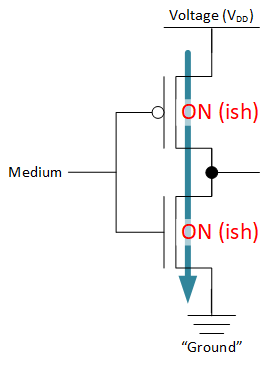
[From the last episode: We looked at different transistor types and saw why it is that, with CMOSA way of connecting MOS (metal-oxide-semiconductor) transistors into a switch that conducts no current when sitting idle., there is no static powerThe rate of energy consumption of a circuit when nothing is switching -- it's just sitting idle..]
Just because CMOS circuits have no static powerThe rate of energy consumption. For electricity, it’s measured in watts (W). doesn’t mean we’re out of the woods. Yeah, it’s possible to say that we’re doing “work” while the circuit is just sitting there, but that work only serves to hold the transistor in whatever stateA broad term that can apply to a lot of systems. Let’s say you have a system that can be one of two ways – on or off. That “on-ness” or “off-ness” is the state of the system. The system is either in an on state or an off state. Many different kinds of systems can have many different kinds of state. There are many complex branches of engineering or physics or even mathematics that deal with state. The easiest way to think of any of them is, “the way things are” (which may depend on the history of prior states, meaning how they got to this particular state). it’s in. The BJTs, by contrast, conducted currentThe amount of electrical flow. Measured in amperes or amps (A). even when doing nothing but holding a state. It’s like the difference between idling a car with your foot on the brake and simply setting the e-brake and shutting off the engine.
More Than Just Sitting Around
But what about when we want to do more than just hold a state? What if we want to change states? Well, that’s more work than you can hope to do with no current. Now you’re taking that input and moving it from LO to HI or vice versa.
That means that, as the gate changes, there’s going to be a medium level in between HI and LO where neither transistor is off. The gate isn’t high enough to turn off the PMOS, and it’s not low enough to turn off the NMOS. They’re both on.
That means that current can flow directly from the supply voltageVoltage is what gets electrons to flow. It's analogous to water pressure, which gets water to flow. Voltage is measured in units of "volts." down to ground through the transistors (sometimes referred to as crowbar current). The transistors do have resistanceForces that tend to reduce the amount of flow or current. Measured in ohms (Ω)., so it’s not quite like you’re doing a metal short, but the resistances are intentionally not high, so the current can be substantial. It would not be a good idea to park the gate at that intermediate voltage and leave it there.

But in digital logic, switching happens pretty quickly. That means that it spends very little time in that in-between state, which means that the current happens only for a short time. And that’s manageable.
What this means is that, for the most part, if a CMOS circuit is sitting there idle, it’s not burning up energy (mostly – again, more on that later). You burn energy only when signals are doing something.
So… What Current Should a Designer Expect?
That actually creates a challenge. In the old days, one of the major specs for a logic chip was the supply current. And with bipolar, you had current whether switching or not. So you could measure the current and set a spec. But with CMOS, you can’t just measure the current with the thing sitting there, because that’s when it’s not conducting current. You have to switch things. Which leads to the question, “Well, how do I specify the current, since the current is going to depend on how many signals are switching and how fast they switch?”
That’s a non-trivial question, and, with some devices, there is no longer a hard spec on total current. Instead, you get a formula or a calculator where you put in estimates of how many signals switch and how often they switch, and that will give you an answer – one that might be valid for only one design. With some chipsAn electronic device made on a piece of silicon. These days, it could also involve a mechanical chip, but, to the outside world, everything looks electronic. The chip is usually in some kind of package; that package might contain multiple chips. "Integrated circuit," and "IC" mean the same thing, but refer only to electronic chips, not mechanical chips., it’s possible that if you cranked up everything all at once – likely in a way that’s probably not a practical use – then you could “burn up” the chip with too much current.
And If I Use Too Much Current?
“Too much current” can have a couple of different effects. The “burn up” thing is for real: lots of current creates lots of heat, and if you don’t have a way to get rid of that heat, well, things can melt. Literally.
Even if things don’t get that far, you have a power supply, which is where the current comes from. That power supply can’t supply infinite current; designers choose one that can provide enough current for the job. If the circuit pulls more current than the power supply can handle, then something’s got to give. That usually means that you will no longer get the voltage you’re supposed to get – the voltage will come down. And, at the very least, with lower voltage, everything will work more slowly than it’s supposed to.
There are other things like “noise” that can mess things up, but we won’t dive into that. Suffice it to say that you don’t want to draw more current than the device is rated for.
This situation is why, if you look at discussions of power, you’ll see the distinction between static power and dynamic powerThe rate of energy consumption of a circuit while it's switching -- that is, while computing or otherwise doing work.. And, for super busy circuits, dynamic power dominates.
Now… what about this thing where I’ve kept saying, “To first approximation…” about zero current? That’s what we’re going to talk about next week.

Leave a Reply